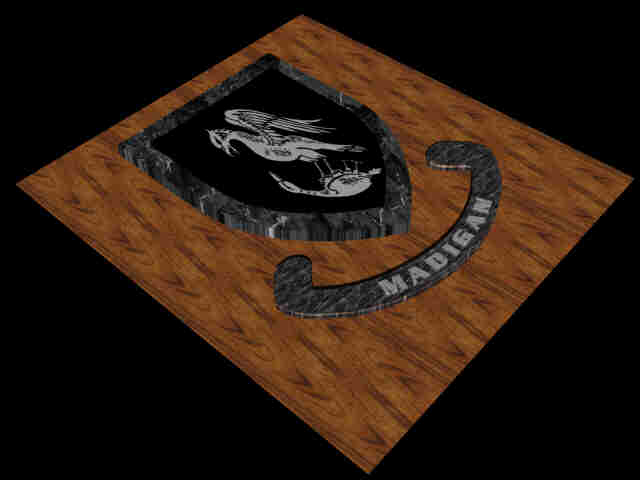Every bit as famous as the Mardi Gras
and the French Quarter is this area's specialized cooking known
as Creole Cuisine. It is an invention of New Orleans 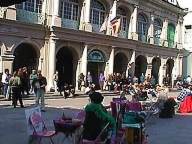 from a
combination of French, Spanish and African influence based on the
availability of certain local food items such as crawfish, turtle
and amberjack. Throughout the Quarter, restaurants and eateries
pour forth an aromatic cacophony to tantalize the senses. Hot and
spicy, the aroma confronted us at every turn of a corner. The
competition is so intense that restaurants have resorted to
barkers standing outside
from a
combination of French, Spanish and African influence based on the
availability of certain local food items such as crawfish, turtle
and amberjack. Throughout the Quarter, restaurants and eateries
pour forth an aromatic cacophony to tantalize the senses. Hot and
spicy, the aroma confronted us at every turn of a corner. The
competition is so intense that restaurants have resorted to
barkers standing outside 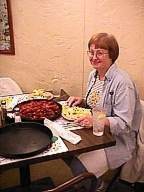 the individual establishments holding samples of
their fare for the passing crowds. Laura would later go on to
attend a cooking school in the Quarter and learn the culinary art
of preparing such delicacies as Oysters Rockefeller, and Shrimp
Creole. We could not pass up the opportunity to order up a big
old bowl of "bawled crawfish" so we could pop those
heads off and suck their tails out. Yum-yum, but hot, oh ya, they
were truly some hot stuff.
the individual establishments holding samples of
their fare for the passing crowds. Laura would later go on to
attend a cooking school in the Quarter and learn the culinary art
of preparing such delicacies as Oysters Rockefeller, and Shrimp
Creole. We could not pass up the opportunity to order up a big
old bowl of "bawled crawfish" so we could pop those
heads off and suck their tails out. Yum-yum, but hot, oh ya, they
were truly some hot stuff.
There are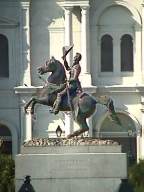 two heroes of New Orleans which are common
names to the area. Andrew Jackson, who defeated the British
attack on New Orleans in 1812 and his somewhat unwilling partner
who carried the day, the pirate Jean Lafitte. Although the battle
was actually fought south of the city it was for possession of
New Orleans that the battle ensued. The battle and the
relationship of its defenders to each other has been the source
of many a great romantic novel.
two heroes of New Orleans which are common
names to the area. Andrew Jackson, who defeated the British
attack on New Orleans in 1812 and his somewhat unwilling partner
who carried the day, the pirate Jean Lafitte. Although the battle
was actually fought south of the city it was for possession of
New Orleans that the battle ensued. The battle and the
relationship of its defenders to each other has been the source
of many a great romantic novel.
The French Quarter has for many years
been a tourist attraction and the local residents, 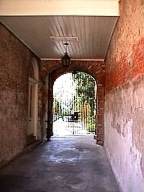 for
which there are many, have developed a method of living which
tolerates the traffic and mischief of the partying crowds. They
built their apartments so that the back faces the street. There
is no lawn in the back. House back leads to sidewalk which leads
to street. On the opposite side, or the front of the apartment is
a court yard, connected to the outside world by one or more
narrow corridors which are completely blocked off from the public
for
which there are many, have developed a method of living which
tolerates the traffic and mischief of the partying crowds. They
built their apartments so that the back faces the street. There
is no lawn in the back. House back leads to sidewalk which leads
to street. On the opposite side, or the front of the apartment is
a court yard, connected to the outside world by one or more
narrow corridors which are completely blocked off from the public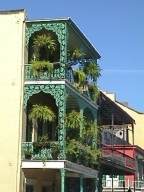 by large
iron gates. This is the living space for the locals, and affords
them some privacy which they guard preciously. The back or
outside is often ornamented by the classic French Quarter balcony
with its appropriate wrought iron railings and hanging baskets.
Elevated high above the street, it affords the resident a safe
quiet perch in which to watch the frantic activities on the
streets below.
by large
iron gates. This is the living space for the locals, and affords
them some privacy which they guard preciously. The back or
outside is often ornamented by the classic French Quarter balcony
with its appropriate wrought iron railings and hanging baskets.
Elevated high above the street, it affords the resident a safe
quiet perch in which to watch the frantic activities on the
streets below.
The official Mardi Gras colors are a vibrant royal purple, gold and green. We were told that the official colors are actually copyrighted and as such protected from improper use without the permission of the Mardi Gras commission. You will see this color scheme in every conceivable decoration throughout New Orleans.
